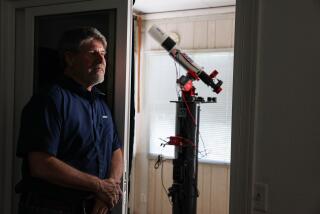Satellite Detects Rapid Pulses From Neutron Star
SAN DIEGO â Astronomers announced Tuesday that a new X-ray satellite launched by NASA in December has already bagged a new species of stellar object: a collapsed star that spits out a stream of X-rays vibrating at an unprecedented rate of 1,130 times per second.
The development may ultimately reveal as much about the unseen universe as stop-action photography revealed about the structure of a simple splash of milk.
Never before has anything in the sky been seen to shake so rapidly. Some scientists speculate that the outbursts are produced by bubbles of radiation bursting on the starâs surface.
Much like the rising pockets of air that create thunderstorms on Earth, the fast-rising bubbles crash up against a ceiling of denser matter. One major difference is that conditions on the star are far more violent, with the equivalent of billions of nuclear explosions going off every second âin every patch the size of a throw rug,â said UC Berkeley astrophysicist Richard Klein, who developed the theory along with colleague Jonathan Arons.
Astronomers believe the discovery of these new vibrations is merely the first of many surprises expected from a new generation of space-borne observatories designed to look at the most energetic objects in space, including black holes.
The results were announced at the meeting of the High Energy Astrophysics division of the American Astronomical Society being held in San Diego this week.
The star sending out the rapid pulses is an exotic variety known as a neutron star and has little in common with its sedate cousins like our sun. Instead, it is the superdense core of a star that eons ago exploded and then fell back in on itself with a crush of gravity so great that its nuclear particles melted into a glob of neutrons.
The matter that makes up the resulting neutron star is so tightly packed itâs as if the mass of 500,000 Earths were condensed into an area the size of San Diego, said astronomer Tod Strohmayer of NASAâs Goddard Space Flight Center in Maryland. âItâs matter at the most extreme conditions that we know in the universe.â
For that reason alone, scientists of all stripes would like to know more about what goes on in a neutron star. But because matter is so compressed on neutron stars, things happen faster than even the best detectors have been able to see.
âIf you bounced a ball on Earth,â explained NASA project scientist Jean Swank, it takes about a second to hit the ground and bounce up again. On the moon, gravity is weaker, so the bounce might take two seconds. âBut on a neutron star,â Swank said, âitâs going to come back a thousand times a second.â Astronomers have been studying extraterrestrial X-rays for several decades now, but never before has an instrument been able to collect enough X-rays rapidly enough to see things happen that fast.
NASAâs new satellite, called Rossi X-ray Timing Explorer (XTE), can see them easily however.
Now astronomers need to explain what they see. They have known for decades that X-rays stream from neutron stars that are gravitationally glued to sun-like companions. According to accepted theory, the huge gravitational pull of the neutron star sucks matter off the larger star.
As the matter falls onto the neutron star, it releases a steady âhissâ of X-rays. âItâs the sound of matter going splat,â Arons said.
The newly discovered star is indeed this kind of double-star system. However, the intense and very rapid regular bursts detected by XTE are new and as yet unexplained. Itâs as if something were shaking the steady stream of X-rays very rapidly, like a child shaking a hose with water streaming out.
These new vibrations were a source of excitement at the San Diego meeting. The fastest bursts, detected by Dutch astronomer Michiel van der Klis, are from a star called Scorpius X-1 in the constellation Scorpius.
Arons and Klein suggest that the astronomers are seeing bubbles of hot radiation, called photon bubbles (or light bubbles), that percolate up from the neutron starâs surface and crash into the matter being sucked into the star. This energy is released in rapid and quasi-regular bursts of X-rays. Klein and Arons claim that the new X-ray bursts detected by the XTE confirm the numbers generated by their computer modeling of how such bubbles would form and grow. âWeâve been experimenting, in a sense, with a very large scale computer,â Klein said. âWe are getting good agreement [with the real thing].â
Still, the question of whatâs behind the X-ray bursts is far from settled. âThe frontier of research is not what is it, but how does it work,â Arons said.





